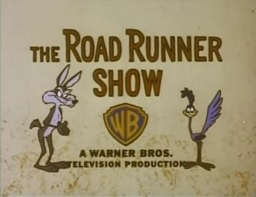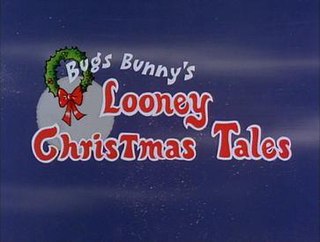Related Research Articles

Isadore "Friz" Freleng, credited as I. Freleng early in his career, was an American animator, cartoonist, director, producer, and composer known for his work at Warner Bros. Cartoons on the Looney Tunes and Merrie Melodies series of cartoons from the 1930s to the early 1960s. In total he created more than 300 cartoons.

The Bugs Bunny Show is a long-running American animated anthology television series hosted by Bugs Bunny that was mainly composed of theatrical Looney Tunes and Merrie Melodies cartoons released by Warner Bros. between 1948 and 1969. The show originally debuted as a primetime half-hour program on ABC in 1960, featuring three theatrical Looney Tunes cartoons with new linking sequences produced by the Warner Bros. Cartoons staff.
Warner Bros. Cartoons, Inc. was an American animation studio, serving as the in-house animation division of Warner Bros. during the Golden Age of American animation. One of the most successful animation studios in American media history, it was primarily responsible for the Looney Tunes and Merrie Melodies series of animated short films. The characters featured in these cartoons, including Bugs Bunny, Daffy Duck, and Porky Pig, are among the most famous and recognizable characters in the world. Many of the creative staff members at the studio, including directors and animators such as Chuck Jones, Friz Freleng, Robert McKimson, Tex Avery, Robert Clampett, Arthur Davis, and Frank Tashlin, are considered major figures in the art and history of traditional animation.

Birds Anonymous is a 1957 Warner Bros. Merrie Melodies animated short, directed by Friz Freleng and written by Warren Foster. The short was released on August 10, 1957, and stars Tweety and Sylvester.

David Hudson DePatie was an American film and television producer who was the last and longest lived executive in charge of the original Warner Bros. Cartoons studio. He also formed DePatie–Freleng Enterprises, with Friz Freleng, Hanna-Barbera Productions and was an executive producer at Marvel Productions.
Hawley B. Pratt was an American film director, animator, designer and illustrator. He is best known for his work for Warner Bros. Cartoons and as the right-hand man of director Friz Freleng as a layout artist and later as a director. Pratt also worked for Walt Disney Studios, Filmation, and DePatie-Freleng Enterprises where he co-created The Pink Panther.

The Road Runner Show is an American Saturday morning animated anthology series which compiled theatrical Wile E. Coyote and the Road Runner cartoons from the Looney Tunes and Merrie Melodies, which were produced by Warner Bros. Cartoons between 1949 and 1964. Several of the shorts, especially the ones produced from 1965 onward, were produced by DePatie–Freleng Enterprises after Warner Bros. closed their animation studio. DePatie–Freleng Enterprises provided the animation for the show's intro, closing credits as well as the wrap-around bumpers.

Bugs Bunny's Looney Christmas Tales is a 1979 animated Christmas television special featuring Bugs Bunny and other Looney Tunes characters in three newly created cartoon shorts with seasonal themes. It premiered on CBS on November 27, 1979.

Speedy Gonzales is a 1955 Warner Bros. Merrie Melodies animated short directed by Friz Freleng from a story by Warren Foster. The short was released on September 17, 1955, and stars Speedy Gonzales and Sylvester.
Road Runner a Go-Go is a 1965 Warner Bros. Merrie Melodies cartoon directed by Chuck Jones, Maurice Noble and Tom Ray. It is one of three cartoons reused from the unsold pilot Adventures of the Road Runner. The short was released on February 1, 1965, and stars Wile E. Coyote and the Road Runner.
The Rebel Without Claws is a 1961 Warner Bros. Looney Tunes cartoon short directed by Friz Freleng. The short was released on July 15, 1961, and stars Tweety and Sylvester.
Chili Weather is a 1963 Warner Bros. Merrie Melodies cartoon directed by Friz Freleng. The short was released on August 17, 1963, and stars Speedy Gonzales and Sylvester.
A Bird in a Bonnet is a 1958 Warner Bros. Merrie Melodies animated short directed by Friz Freleng. The voices were performed by Mel Blanc, Daws Butler and June Foray. The short was released on September 27, 1958, and stars Tweety and Sylvester.
Rushing Roulette is a 1965 Warner Bros. Merrie Melodies cartoon directed by Robert McKimson. The short was released on July 31, 1965, and stars Wile E. Coyote and the Road Runner. It was the second Road Runner cartoon directed by someone other than Chuck Jones, who had almost exclusively used the characters since their debut in 1949. McKimson directed one other Road Runner cartoon the following year, Sugar and Spies.

Mexican Boarders is a 1962 Warner Bros. Looney Tunes cartoon short directed by Friz Freleng. The short was released on May 12, 1962, and stars Speedy Gonzales and Sylvester. Voice actors are Mel Blanc, and Tom Holland as the narrator.
Nuts and Volts is a 1964 Warner Bros. Looney Tunes cartoon short directed by Friz Freleng. The short was released on July 20, 1964, and stars Speedy Gonzales and Sylvester.
Cats and Bruises is a 1965 Warner Bros. Merrie Melodies cartoon directed by Friz Freleng and Hawley Pratt. The short was released on January 30, 1965, and stars Speedy Gonzales and Sylvester.
Road to Andalay is a 1964 Warner Bros. Merrie Melodies animated short directed by Friz Freleng and Hawley Pratt. The short was released on December 26, 1964, and is one of the last shorts to feature Speedy Gonzales and Sylvester.
References
- ↑ Beck, Jerry (1991). I Tawt I Taw a Puddy Tat: Fifty Years of Sylvester and Tweety. New York: Henry Holt and Co. p. 153. ISBN 0-8050-1644-9.
- ↑ Beck, Jerry; Friedwald, Will (1989). Looney Tunes and Merrie Melodies: A Complete Illustrated Guide to the Warner Bros. Cartoons. Henry Holt and Co. p. 351. ISBN 0-8050-0894-2.
- ↑ Lenburg, Jeff (1999). The Encyclopedia of Animated Cartoons . Checkmark Books. pp. 137. ISBN 0-8160-3831-7 . Retrieved 6 June 2020.